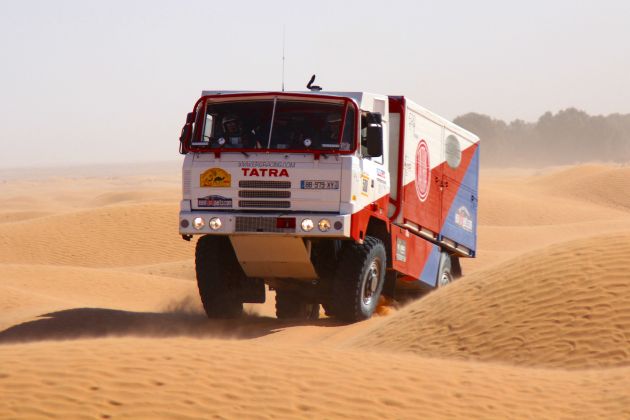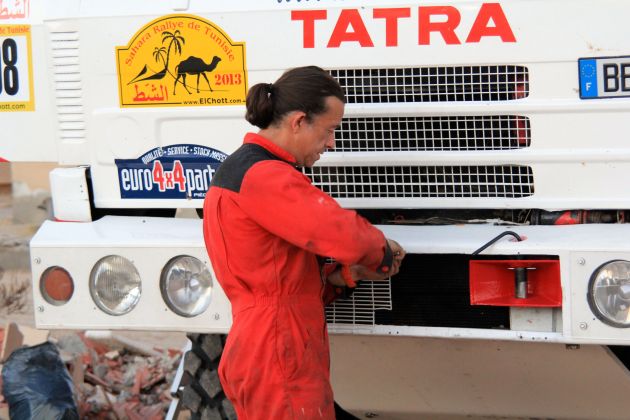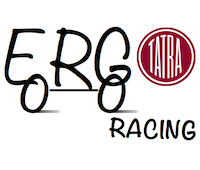El Chott 2013: Kebili – Hammamet
November 27, 2013 1 Comment
Stage 11 included the last Special of the rally, after which we’d head northeast to Sfax and then north to Hammamet for the prize ceremony at the Sultan Hotel.
Just after breakfast, we checked the lobby where the organization was posting rally information. The Chott was dry, so the special stage would take us through the Chott to the finish line in the foothills of the small mountain range to the north. At the driver’s briefing, Jörg had reminded us that it was dangerous to leave the pist in the Chott, we could get seriously stuck, and the roadbook was clearly marked for about 20 kilometers, “Do not leave the pist.” We were a little worried. Sometimes it isn’t obvious where the “piste” is; the tracks sometimes diverge or become confusing. If we had a problem, it could be difficult to recover the truck.
The piste was fast at the start of the stage, and we quickly came to the wide plain of the salt flat of Chott El Fejej. We were reassured to find that there was no ambiguity, the track was straight and clear. At first the sand was firm, but as we got further into the Chott, there were some areas where it became very soft and we could feel the wheels slipping and the engine working harder to drive us through. At several points, we could see the tracks of the cars that had already passed were becoming quite deep and we hoped we’d be able to make it through with only 2-wheel drive.
With just a few kilometers to go, we reached a very soft area a few hundred meters long. We got just over halfway through when the front right wheel on the broken axle shaft started sinking down. Very quickly, almost before we could react, the Tatra slowed to a stop, leaning sharply to the right. We slowly backed out of our tracks to try another trajetory to the left. During this time we were passed by several rally cars. The Unimog passed, but didn’t dare stop in this location to help us. There wouldn’t have been much they could have done anyway. We weren’t stuck, and didn’t need to shovel, but we had to move slowly to back out of our tracks enough to take another direction. We tried two or three times, but each time the sand was just too soft and we were starting think we might not get through at all.
After a while, the MAN KAT trucks from the organization arrived and stopped just behind us. They weren’t sure they could cross either even without a broken axle shaft. One truck slowly passed through on the far left and made it, stopping just past the soft area at the foot of a small dune. We discussed with them, deflated our right front tire manually to the minimum pressure we could use and then tried the same spot. We got through, but we’d lost a lot of time and if we inflated our tire again manually, we’d have lost even more. We weren’t sure we could make the Stage finish in the maximum allowed driving time, but we were determine to do our best.
Once we made it through the Chott, the piste at the foot of the mountains became rather technical and we had to cross several oueds where the track was quite dangerous because erosion on the shoulder had created deep crevices. The tracks were often stony and we weren’t comfortable driving too fast with our deflated tire. If we stopped to inflate it or had a flat, we certainly wouldn’t make the finish in time.
Fortunately, the technical section wasn’t too long, and the piste was flat and fast on the last kilometers of the Special. We reached the finish late, but we made it! We stopped to inflate our tire before beginning the 200 km liaison to Hammamet.
We arrived at the hotel after dark and quickly took care of the necessary maintenance for the Tatra, inspecting everything and cleaning out the water separator, which seemed cleaner than it had been on the previous days. We showered before going to the buffet dinner and settling in the meeting room where the prize ceremony would be held.
The rally had been difficult, and we had done at least three-quarters of it with only 2-wheel drive. We had encountered a number of set-backs: the broken axle shaft, the fuel problem, and the departure of our mechanic. There were many occasions when we could have decided it was just too hard and given up, but we didn’t. We went to the starting line everyday. We had come to live up to the challenge and to learn so we were determined to do our best to finish, and we did! Along the way, we learned a lot, met some wonderful people and had a fabulous experience that we hope will allow us to improve our driving, navigation and overall performance for next year. Receiving the 2nd place trophy in the truck category was an unexpected reward for all our tribulations.
On the ferry home while our experience was fresh, we made our wish list of modifications to the Tatra for the next rally. Last Friday we drove it to Kopřivnice where it will spend the winter during the upgrades and the repair of the broken axle shaft.
Go back to the start.


































